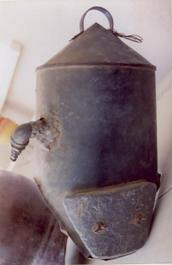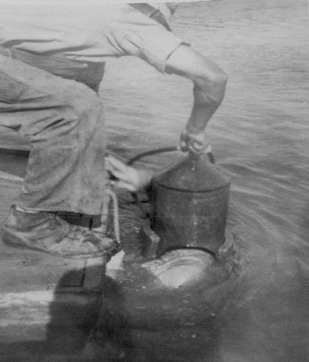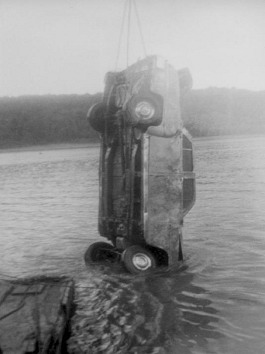
Introduction
Bert Cutting – The Blind Diver
According to the family history told by Harry Cutting, Bert Cutting's eldest son, the cartoon hero "Dick Tracy" is given credit for Bert becoming a diver. Bert, born in 1894, lost his eyesight at the age of 15 from complications of typhoid fever. In 1936, while the family was living in Illinois on the Little Wabash River, Bert and his son Harry were "musseling" along the shores. Before the development of plastics, the mussels were used to make buttons. Using a john boat and holding onto the side with one hand, Bert used his bare feet to find the mussels buried in the mud of the banks and sandbars. He would duck under the water and scoop up the mussels with his free hand. Young Harry's job was to guide the boat, watching for fallen trees, snags and debris as his father rowed them from place in their search for shells.

One of Harry's other duties was to read the newspaper to his Dad. It was while reading the Dick Tracy comic strip one day that Bert came up with the idea of working under water. The comic strip story was about Dick Tracy chasing a crook through Central Park. The crook managed to escape by jumping into a lake, and with a reed to breathe, hides under the lily pads. Over the next few days, Bert tried several of his ideas for breathing underwater. He first tried rigging up a piece of hose to use instead of the reed used by Dick Tracy, but water went up his nose. The next day he clamped a clothes pin on his nose, but this caused too much pressure to build up in his head. After several unsuccessful tries, he contacted the Miller-Dunn Diving Company in Florida. He explained to them his ideas and his need for getting into the deeper water. The Miller-Dunn engineers drew up plans for Bert's first helmet, a windowless, shallow water helmet very similar to the famous Miller-Dunn Divin Hoods.
 |
 |
It was designed to receive air from a two cylinder tire pump which would pump on both the up and down strokes. Bert took the Miller-Dunn plans to a metal worker in Marion, Indiana, but realizing that his young sons could not sit and hand pump air all day, he substituted a connection for a garden hose to replace the small air hose fitting of the Miller-Dunn plan. He then bought a paint spray compressor for $10, connected a section of water hose and used the gasoline motor from his wife's Maytag washer to run the compressor. From that time on Bert Cutting was a diver.
Bert spent the summers diving, often staying underwater for six hours at a time using his unique hand-made hat, barefoot, and wearing only a bathing suit. On a good day Bert could recover 120 pounds of mussel shells, which brought $40 to $100 a ton, according to the quality, at the button factories. (That is $2.40 to $6.00 per day!) His mother, Della Cutting, or one of his young sons, remained in the boat to operate the old washing machine motor and compressor. With a guideline attached to his waist and carrying a wire basket over his arm, he would walk around underwater using his hands and feet to find the shells. Because of the cold water temperatures, the diving was primarily summer work. Occasionally during the winter, a small job would come along such as raising a boat, but for the most part he worked cutting timber. His 15 year-old son Harry, worked with him using a cross-cut saw. When the tree came down, he simply held onto the saw trusting his son to lead him away from the danger of the falling tree. They even fell the trees and had them milled to build their own cabin.
During the Depression years and into the '40s, Bert continued musseling, but with the development of plastics, pearl buttons made from the mussel shells soon became a thing of the past. Bert continued diving doing salvage jobs whenever they came his way. Overcoming his handicap wasn't as difficult as convincing people that a blind man was as capable as the next man. "There's always been plenty of work available," stated Bert, "but the job has been to convince the other fellow that a blind man can do it."
In 1941, an oil truck went off the end of a ferry into the Wabash River. The driver spent a good week trying to find a sighted person to retrieve the truck, but finally contacted Bert. It took all of 20 minutes for Bert to get a line hooked up and have the truck pulled out. A few weeks later the same thing happened on the opposite side of the river. Having made a believer out of the first trucker, Bert was called immediately and that truck was also pulled out in short order. In 1942, Bert had "a nice job" on the Ohio River laying 180 feet of 12 inch pipe for a waterworks. The pipe was assembled above water and floated with oil drums. Bert simply went along and cut away the drums, allowing the pipe line to settle on the river bed.
The Cuttings then moved to Mattoon, Illinois where he was employed as a broom maker and his wife, Eila, did rug weaving and chair caning. Bert continued to dive, salvaging several boats that had sunk and doing other salvage jobs. He also recovered a couple of bodies, a gruesome task, for which he always refused payment.
It was a surprise to find Bert's military registration for WWI, but even more amazing was the story his son's told of how he tried to enlist in the Navy during WWII. He felt that his unique ability to work in total darkness would be an asset when working underwater at night. After being turned down by the Navy, Bert then came up with a proposal to train blind people for war emergency work but received a cold shoulder from the military. He continued with his campaign by writing letters to President Roosevelt and felt that something might have been done if not for untimely death of the President.
His most successful and profitable venture was the job of recovering 146 new cars and a barge from the Ohio River near Golconda, Illinois in 1952. There were a number of newspapers who covered the feat as well as attracting the attention of Robert Ripley of Ripley's Believe It or Not. Ripley determined that true to Cutting's claim, he was the only blind commercial diver known at that time.

The barge loaded with 155 new cars (Dodges, DeSotos and Plymouths), went to the bottom of the river in December 1951 during a snow storm. By June of 1952, two large salvage companies had attempted to recover the vehicles and after spending large sums of money, had given up. The first project failed with one car salvaged at a cost of $35,000. Three cars recovered by the second effort were in poor condition after being underwater for several months. Those cars were beached on the river bank to dry out, only to be striped by river pirates a few days later. Five of the cars were lost when they washed down river and were never recovered.
Directing the third attempt was Thomas Strickland, Sr., another blind man and head of the Strickland Construction Company in Moline, Bert and Strickland, Sr. met by chance at a St. Louis insurance office handling the insurance claims for the vehicles and barge. The two blind men formed up a working partnership with Strickland's son, Thomas Jr., and took on the job of salvaging $300,000 worth of vehicles and a large river barge.
Tom Strickland, Jr. was the foreman in charge of cleaning, selling, and providing security; Bert Cutting was the diver; and Tom Sr. financed the venture. A requirement of the insurance company was to have a secondary diver. Bert's youngest son, fourteen-year-old Carroll (Shorty) Cutting, was immediately pressed into service and worked with his Dad during the entire operation except for the last two days when he had to return to school for the Fall term. During the salvage operation the Cutting family lived on a house boat tied to the barge in order to keep the river pirates and other salvage hunters away from the site.

Bert, working in approximately 15 to 24 feet of muddy water, barefooted, wearing swim trunks, a vest loaded with weight, his hand-made shallow water helmet with no port, and his garden hose connected to a small air compressor, began bringing up the cars. Working underwater, six to eight hours at a stretch, barking his shins and cutting fingers on broken windshields and twisted metal, Bert laboured for 100 days to complete the job, salvaging 146 of the original 155 cars. The cars were hauled onto the river bank to dry out and were then ferried upstream to Golconda.

There they were sold for $800 each with no regard to the make or model as many of the Dodges and Plymouths were convertibles or hardtops. The cars were in good condition mechanically, with damage only to the bodies and in need of new upholstery. Salvaging the barge was "a little more of a problem". First they had to pump out about 300 ton of mud and then plug the numerous openings in the decks with planking, corking or cement-filled burlap bags. Once they were able to refloat the barge, it was an easy tow up the river.

With the $10,000 from the salvage job in his pocket, Bert bought one of the cars, a 1952 Plymouth station wagon, and took his first vacation. With daughter Marguerite doing the driving, Bert, his wife Eila, his mother, and son "Shorty", the family journeyed to California for a visit with Harry and his family. While in the L.A. Harbour area, Bert contacted several commercial divers, including E.R. Cross (HDM Issue #37, p. 22) to investigate the possibility of working as an abalone diver. But, he was unable to overcome the preconceived opinions of the sighted divers, that a blind man was not capable of doing the job just as well as anyone else.
The old saying goes, 'You can't keep a good man down,' and it certainly applied to Bert Cutting. Soon after going blind he attended the Indiana School for the Blind at Indianapolis. By the time he was 19 he had attended Marion Business College and became a Steno typist. On August 27, 1914, The Marion Daily Star carried the story of nineteen year old Bert Cutting using a Stenotype Machine to record a speech by the Governor of Indiana, earning for himself the distinction of being the first blind shorthand reporter. He was also a graduate of a Chiropractic School. It was while attending the Blind School that he met the woman who was to become his wife. Eila was also blind from the improper use of a medication in her eyes as an infant. Bert and Eila were married on February 2, 1919, raising six children. Discussing the family in 1969, Eila was quoted as saying, "We've had our ups and downs like any family, but my husband and I have been a happy, congenial couple. God has been good to us."
Note: In August 2006, on the day we turned up on Harry Cutting's doorstep, his first comment was, "I knew that someday, someone would show up about my Dad!" Many thanks to Harry Cutting and Carroll "Shorty" Cutting for sharing the pictures, news clippings and memories of their father, Bert Cutting.
Many Thanks to
Dorothy Barstad of California Classic Equipment Divers who wrote the article
and Warren Hastings who introduced Bert’s Story to Diving Heritage.
Copyrighted by Dorothy Barstad and the Cutting Family.